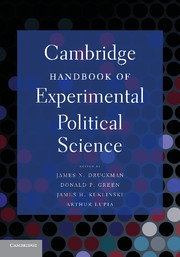Book contents
- Frontmatter
- Contents
- List of Tables
- List of Figures
- Contributors
- Acknowledgments
- INTRODUCTION
- PART I DESIGNING EXPERIMENTS
- PART II THE DEVELOPMENT OF EXPERIMENTS IN POLITICAL SCIENCE
- PART III DECISION MAKING
- PART IV VOTE CHOICE, CANDIDATE EVALUATIONS, AND TURNOUT
- PART V INTERPERSONAL RELATIONS
- PART VI IDENTITY, ETHNICITY, AND POLITICS
- 20 Candidate Gender and Experimental Political Science
- 21 Racial Identity and Experimental Methodology
- 22 The Determinants and Political Consequences of Prejudice
- 23 Politics from the Perspective of Minority Populations
- PART VII INSTITUTIONS AND BEHAVIOR
- PART VIII ELITE BARGAINING
- PART IX ADVANCED EXPERIMENTAL METHODS
- AFTERWORD
- Name Index
- Subject Index
- References
23 - Politics from the Perspective of Minority Populations
Published online by Cambridge University Press: 05 June 2012
- Frontmatter
- Contents
- List of Tables
- List of Figures
- Contributors
- Acknowledgments
- INTRODUCTION
- PART I DESIGNING EXPERIMENTS
- PART II THE DEVELOPMENT OF EXPERIMENTS IN POLITICAL SCIENCE
- PART III DECISION MAKING
- PART IV VOTE CHOICE, CANDIDATE EVALUATIONS, AND TURNOUT
- PART V INTERPERSONAL RELATIONS
- PART VI IDENTITY, ETHNICITY, AND POLITICS
- 20 Candidate Gender and Experimental Political Science
- 21 Racial Identity and Experimental Methodology
- 22 The Determinants and Political Consequences of Prejudice
- 23 Politics from the Perspective of Minority Populations
- PART VII INSTITUTIONS AND BEHAVIOR
- PART VIII ELITE BARGAINING
- PART IX ADVANCED EXPERIMENTAL METHODS
- AFTERWORD
- Name Index
- Subject Index
- References
Summary
Experimental studies of racial and ethnic minorities in the United States have focused on the influence of racial considerations in political reasoning, information processing, and political participation. Studies have analyzed the types of messages and frames that prime racial evaluations of issues, the effect of racial arguments on opinions, and the impact of racial cues on political choices. Underlying this research is the premise, developed in observational studies (e.g., Bobo and Gilliam 1990; Dawson 1994; Tate 1994; Lien 2001; Chong and Kim 2006; Barreto 2007), that there are racial and ethnic differences in how individuals respond to cues and information. For this reason, almost all studies give special attention to the mediating and moderating influences of racial group identification, a core concept in the study of minority politics.
There are too few studies yet to constitute a research program, but the initial forays have successfully featured the advantages of experimental design and distinct perspectives of minority groups. We review the methodology and findings of these experimental studies to highlight their contributions and limitations and to make several general observations and suggestions about future directions in this field. As we show, randomization and control strengthen the internal validity of causal inferences drawn in experiments; however, of equal importance, the interpretation and significance of results depends on additional considerations, including the measurement of variables, the external validity of the experiment, and the theoretical coherence of the research design.
- Type
- Chapter
- Information
- Cambridge Handbook of Experimental Political Science , pp. 320 - 336Publisher: Cambridge University PressPrint publication year: 2011
References
- 7
- Cited by

